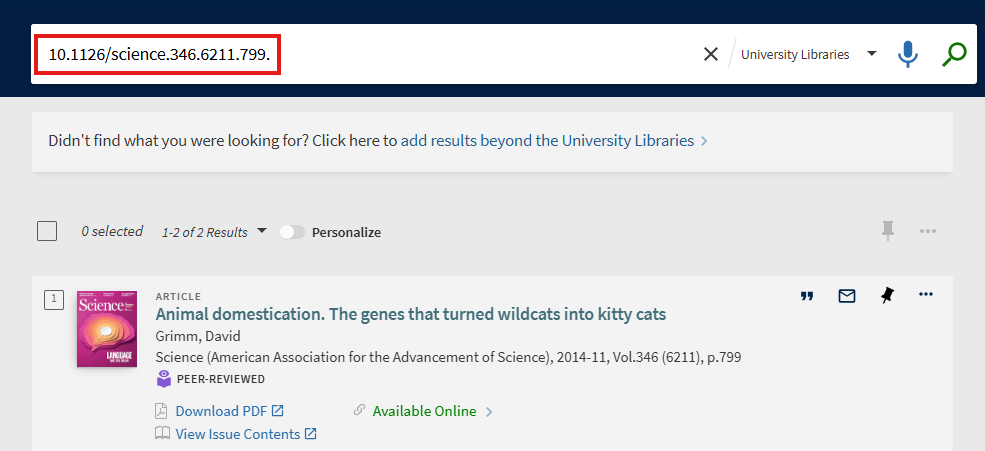A DOI (digital object identifier) is a string of numbers and letters assigned to an electronic publication. It serves as a permanent link to the source. Most journal articles published within the last twenty years will have a DOI, and many older articles have had DOIs assigned to them retroactively.
Find it
DOIs are found near the publication information at the top of an article or on the full item record in a database. You can also find the DOI in the source’s citation. In Library Search, the DOI is usually listed in the “Details” section under “Identifier.”

Search it
You can search for an article in Library Search or another search engine by pasting the DOI number directly into the search box. This is especially helpful if you find a source in another publication’s reference list and want to access it quickly.
 A search for an article using the DOI. The DOI appears in the search box and is enclosed in a red rectangle. The successful search result is located underneath the search box.
A search for an article using the DOI. The DOI appears in the search box and is enclosed in a red rectangle. The successful search result is located underneath the search box.If the article does not come up in Library Search, try searching the number on doi.org. You can also search for most DOI numbers quickly by turning it into a functional hyperlink using this format: https://doi.org/YOUR_DOI. That will take you directly to whatever online database is currently hosting the article. If you are searching off campus, you may run into a paywall. Learn how to avoid paywalls.
Use it
When citing an electronic article, use the DOI (when available) in place of the URL to document the location of the source or as required by the particular citation style you are using. DOIs are more stable than URLs, meaning the citation information will always be valid for that article.
- APA 7 example: Otranto, D., Huchet, J. B., Giannelli, A., Callou, C., & Dantas-Torres, F. (2014). Enigma of the dog mummy from Ancient Egypt and the origin of ‘Rhipicephalus sanguineus.’ Parasites & Vectors, 7(1), 2-2. https://doi.org/10.1186/1756-3305-7-2
- MLA 9 example: Otranto, Domenico, et al. “Enigma of the Dog Mummy from Ancient Egypt and the Origin of ‘Rhipicephalus Sanguineus.’” Parasites & Vectors, vol. 7, no. 1, 2014, pp. 2-2. PubMed Central, https://doi.org/10.1186/1756-3305-7-2.
You can find the guide for citing articles in MLA, and the guide for citing articles in APA here.